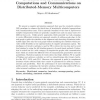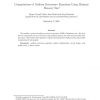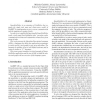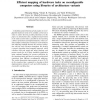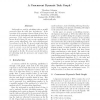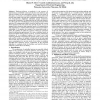CJ
1999
14 years 3 months ago
1999
We present a compiler optimization approach that uses the simulated evolution (SE) paradigm to enhance the finish time of heuristically scheduled computations with communication t...
SIAMCOMP
2000
14 years 4 months ago
2000
We consider a system of uniform recurrence equations (URE) of dimension one. We show how its computation can be carried out using minimal memory size with several synchronous proc...
GRID
2008
Springer
14 years 4 months ago
2008
Springer
SmartGridSolve is an extension of GridSolve that expands the single task map and client-server model of GridRPC by implementing server to server communication and the mapping of a...
ACTAC
2007
14 years 4 months ago
2007
An o-line scheduling algorithm considers resource, precedence, and synchronisation requirements of a task graph, and generates a schedule guaranteeing its timing requirements. Th...
CODES
2005
IEEE
14 years 6 months ago
2005
IEEE
System design based on static task graphs does not match well with modern consumer electronic devices with dynamic stream processing applications. We propose the TTL API for task ...
CP
2006
Springer
14 years 8 months ago
2006
Springer
This paper describes a complete and efficient solution to the stochastic allocation and scheduling for Multi-Processor System-on-Chip (MPSoC). Given a conditional task graph charac...
FCCM
2009
IEEE
14 years 8 months ago
2009
IEEE
Scheduling and partitioning of task graphs on reconfigurable hardware needs to be carefully carried out in order to achieve the best possible performance. In this paper, we demons...
ICPP
1993
IEEE
14 years 8 months ago
1993
IEEE
Task graphs are used for scheduling tasks on parallel processors when the tasks have dependencies. If the execution of the program is known ahead of time, then the tasks can be st...
DAC
1997
ACM
14 years 8 months ago
1997
ACM
: Hardware-software co-synthesis is the process of partitioning an embedded system specification into hardware and software modules to meet performance, power and cost goals. In t...
ICPADS
1998
IEEE
14 years 8 months ago
1998
IEEE
The DAG-based task graph model has been found effective in scheduling for performance prediction and optimization of parallel applications. However the scheduling complexity and s...
